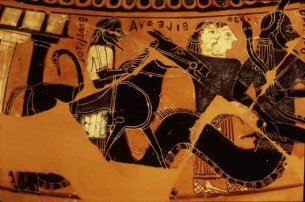
The Melammu ProjectThe Heritage of Mesopotamia and the Ancient Near East |
The Melammu Project
General description
Search string
Browse by topic
Search keyword
Submit entry
About
Open search
Thematic search
Digital Library
Submit item
Ancient texts
Dictionaries
Projects
Varia
Submit link
FAQ Contact us
About
The Newsletter
To Project Information >
Tiamat and Tethys (1) |
Printable view |
|
Topics (move over topic to see place in topic list) 04 Religious and philosophical literature and poetry 01 Religious and ideological doctrines and imagery 01 Religious and ideological doctrines and imagery |
Keywords gods Greek language naming primordial causes |
|
Period Neo-Assyrian Empire |
Channel No channel specified |
|
Text
Sources (list of abbreviations) (source links will open in a new browser window)
Amar Annus
|
Illustrations (click an image to view the full-size version in a new window)
 |
Fig. 1: Tethys’ name written Thethys on the dinos of Sophilos, ca. 580 BCE. |